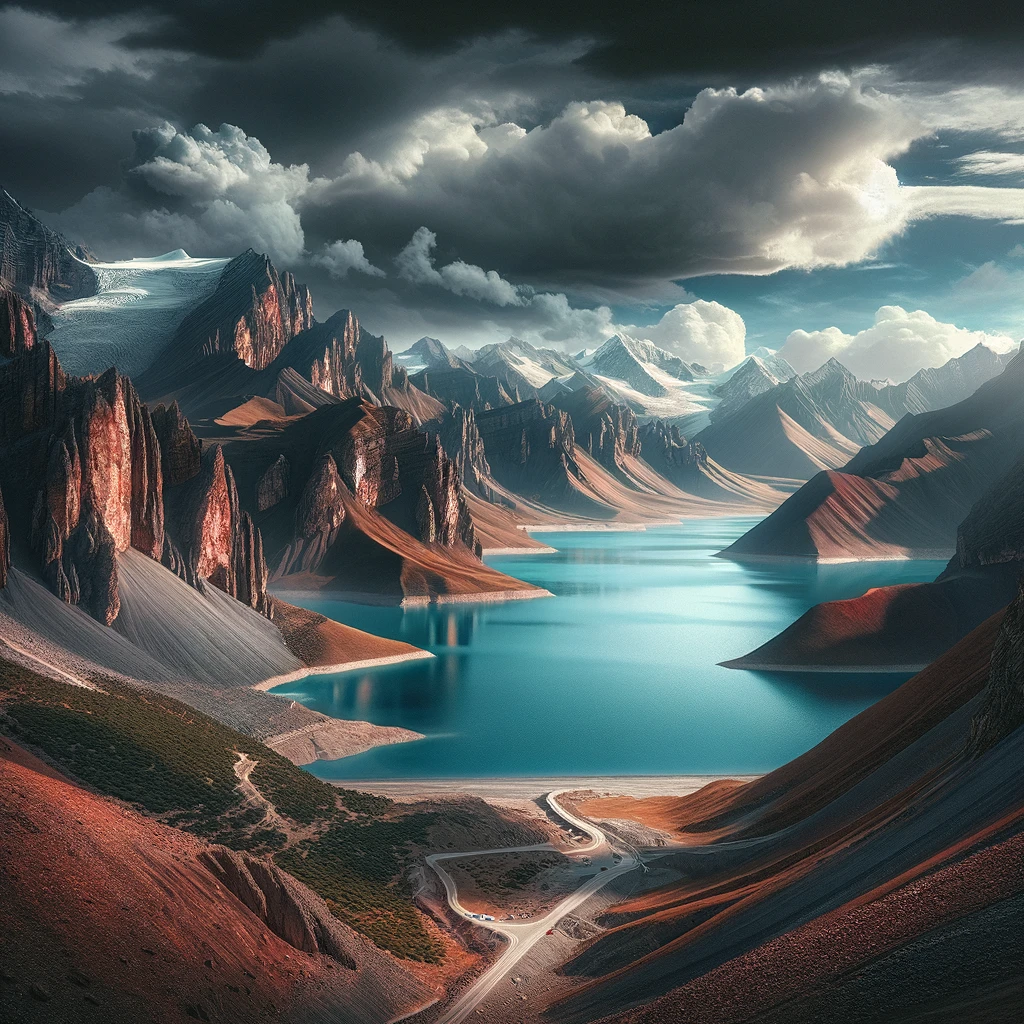
Journey to the Mystical Lake Tangra Yumtso
Embark on a captivating journey to Lake Tangra Yumtso, a revered site nestled in the heart of North Tibet. Starting from Nyima county, a mere 8 kilometres southwest leads you to a crossroad. Here, turn left and continue southwards for about 80 kilometres. Traverse a mountain pass at an elevation of 5,000 meters to enter the enchanting basin of Lake Tangra Yumtso.
The Sacred Waters of Lake Tangra Yumtso
A Holy Site for Bon Religion Followers
Lake Tangra Yumtso, held sacred by followers of the Bon religion, lies in a deep lake basin alongside its sibling, Tangra Chotso. These twin lakes, once united, share a rich history, evident in their names - 'Tangra Chotso' in Tibetan. The unique feature of this lake is its ability to change colours up to three times a day, a phenomenon that adds to its mystical allure.
The Majestic Tangra Yumtso Landscape
The western bank of the lake is adorned with dark red cliffs, forming a natural screen that records the lake's historical water levels. Eroded stone steps circle the lake, creating a pathway from the mountaintop to the lakefront. Further exploration reveals the larger Lake Tangra Yumtso, renowned as the most sacred lake in North Tibet.
 #image_title
#image_titleDargo Mountain and Yubon Monastery
The Seven-Peaked Guardian
Dargo Mountain, with its seven pyramid-like peaks, stands guard to the south of the lake. This mountain, along with Lake Tangra Yumco, is venerated as a holy place by the Bon faithful.
The Ancient Yubon Monastery
Beside the lake, within a cliffside cave, lies the Yubon Monastery, believed to be the oldest in the Bon religion. This monastery symbolizes the deep spiritual connection between the land and its people.
Life in Wenbu Village
A Community in Harmony with Nature
The shores of Lake Tangra Yumtso are home to Wenbu, a small village of nearly 100 households. The villagers, unfazed by earthquakes or the nearby active volcanic mountain, view Wenbu as their paradise. Here, agriculture and livestock farming coexist, with crops like Highland barley, tomatoes, and green Chinese cabbages thriving at elevations above 4,500 meters, thanks to the unique climate of the Lake District.
A Warm Winter Haven in North Tibet
Contrary to the harsh winters typical of North Tibet, Wenbu enjoys milder temperatures. Visitors often find the heavy winter coats necessary elsewhere in the region are unnecessary here. Remarkably, the area boasts a thriving Tibetan barley wine industry, with yields reaching up to 3,000 kg per hectare, a testament to the region's unique climate.
A Hidden Treasure in Tibet's Landscape
Lake Tangra Yumtso and its surrounding region offer a unique glimpse into the natural beauty and cultural richness of North Tibet. From its sacred waters to the resilient community of Wenbu, this area stands as a testament to the harmonious coexistence of nature and the human spirit. A visit to Lake Tangra Yumtso is not just a journey to a destination; it's an exploration into a world where every element tells a story of reverence, resilience, and beauty.
The Enchanting Legends of Wenbu Village and the Bon Religion
The Story of Dargo Mountain and Lake Tangra Yumtso
Long ago, the inhabitants of Wenbu faced a dire struggle for survival, unable to grow enough highland barley and reliant on trading salt for barley over vast distances. Witnessing their plight, the couple Dargo Mountain and Tangra Yumtso Lake, personified as husband and wife, intervened. Dargo Mountain embarked on a perilous journey, acquiring a bag of highland barley. However, during his return, an arrow pierced the bag, causing barley to spill. By the time he reunited with his wife, Tangra Yumco Lake, only a few grains remained. He sowed these near the lake, and Tangra Yumco nourished them with her milk, leading to the flourishing barley fields in Wenbu.
The Legacy of Gratitude
In gratitude, the villagers have since honoured these sacred entities with sacrifices of locally brewed barley wine before important agricultural events, maintaining a deep reverence for the holy mountain and lake.

The Mystical Bon Religion in Wenbu near Lake Tangra Yumtso
A Unique Practice: Leftward Sutra Spinning
At Wenbu Village’s entrance stands a Sutra Wheel Spinning House, home to a giant sutra tube turned leftward in silence, a distinctive practice of the Bon religion. This leftward motion aligns with the earth's orbit around the sun, echoing ancient wisdom found in rock paintings and the cosmic movements of the solar system.
The Origins and Teachings of Bon
The Bon religion, believed to be the world's oldest, was founded by Tunba Sinrao. Its scriptures, the Gangyur and Dangyur, encompass teachings on the universe's origin, worshipper biographies, prayers, rituals, and knowledge spanning from medicine to industrial arts. These teachings have been preserved orally and hidden in caves and crevices across Tibet.
The Vision of Dangla Garcha
A significant Bon scripture, the Dangla Garcha, originated from a vision seen by an eminent Bon monk near Wenbu. This scripture describes a goddess descending from heaven to Tangra Yumtso Lake, bringing heavenly treasures and wonders to Tibet, a narrative that has become a cherished part of Bon's religious literature.
A Tapestry of Myth and Spirituality
The legends and religious practices of Wenbu Village offer a window into a world where myth intertwines with the daily lives of its people. These stories and rituals, rich in symbolism and reverence, highlight the profound spiritual connection between the villagers, their land, and the universe. A visit to Wenbu is not just a physical journey but a voyage into the depths of ancient wisdom and enchanting folklore.
https://bit.ly/3Sh6dJ9
Comments
Post a Comment